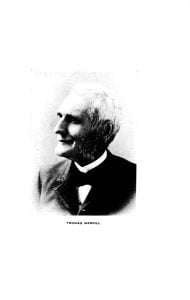Thomas Merrill, though not the earliest pioneer of the Saginaw Valley lumber business, became a significant figure in the industry. Born on April 13, 1815, in Carmel, Maine, he initially worked in farming and local lumbering. In 1849, he owned a sawmill and by 1856, he relocated to Michigan, forging a successful lumbering operation alongside partners like Cyrus Woodman and Henry Corwith, handling massive quantities of lumber without loss. With lumbering’s decline, Merrill diversified into other enterprises and real estate. He married Miss Marie Benjamin and had three children. Respected for his reliability and integrity, Merrill died in 1912 as Saginaw County’s oldest resident, known for his substantial contributions to both business and community life.

While it might not be appropriate to speak of Thomas Merrill as one of the early pioneers of the lumber business in the Saginaw Valley, since he was preceded by the Williams Brothers, Albert Miller, Curtis Emerson, Charles W. Grant, and others, yet it is entirely within the truth to say that few men have occupied a more prominent place in the industry than he. Born in Carmel, Maine, on April 13, 1815, his boyhood was spent at the family homestead, and he received his early education in the district schools. He worked steadily on his father’s farm until at the age of twenty-five he purchased land for himself and combined farming with lumbering in the woods of his native state. In 1849, he traded his farm for a sawmill on the Penobscot, fifteen miles from Bangor, and began cutting the excellent spruce and hemlock which abounded on the waters tributary to that stream.
He was thus occupied until October 1853, when he sold his sawmill and came to Michigan. Two years later, he returned to Maine intending to settle down on a farm, but the enchantment of the Michigan forests of white pine proved irresistible, and in 1856, he again came to this state and located in Gratiot County. In connection with Charles Merrill of Detroit, he commenced lumbering on the Pine River, which continued for four years. They then purchased a tract of pine timber on the Chippewa River, upon which they lumbered for the next six years.
In 1864, he formed a partnership with Cyrus Woodman of Boston and Henry Corwith of Chicago, and the firm purchased large tracts of pine on the Tobacco River. Mr. Merrill had entire charge of the lumbering operations, and so successful was his management, covering a period of eighteen years, that during that time his partners did not desire to examine his accounts. Not a dollar was lost in the important project involving extremely heavy operations, in which the firm handled fully four hundred million feet of logs and lumber, a large proportion of which was cut on the Tittabawassee River and its tributaries. During these operations, Mr. Merrill was prominently identified with the Tittabawassee Boom Company, which was organized in 1864 for the economical handling of logs and continued its operations until 1895.
With the decadence of lumbering in this section due to the depletion of the forests, Mr. Merrill became interested in various enterprises in the Upper Peninsula and in Wisconsin. In 1882, in company with Abel Brockway, he purchased large tracts of land in the State of Washington and in British Columbia, which abounded in Douglas fir and cedar of the Pacific Coast.
On June 16, 1853, Mr. Merrill married Miss Marie Benjamin of Newport, Maine. Three children were born to them, namely: Thomas Davis Merrill, now a resident of Duluth, Minnesota; Lizzie Palmer Merrill, who became the wife of Clark L. Ring, and Richard Dwight Merrill, of Seattle, Washington.
Mr. Merrill lived to a hearty old age and enjoyed an abundant share of physical well-being. He displayed an unusual amount of mental vigor, attending to various business matters almost to the day of his death. He died on October 3, 1912, in his ninety-eighth year, the oldest man in Saginaw County.
From the time of his arrival in the Saginaw Valley, his word was known to be a synonym of reliability, and his judgment was recognized as safe in every particular. As a citizen, he enjoyed a high measure of respect from friends and business associates and richly merited their confidence. His public spirit was shown in the erection of some of the most substantial business blocks on the West Side, notably the Merrill Building, on the corner of Court and Michigan Avenues, and the one adjoining on Michigan occupied by the post office.
For many years, Mr. Merrill was a Democrat, but afterward became affiliated with the Prohibition party. He was an elder in the Presbyterian Church and was deeply interested in its extensive work. His memory is held in high reverence as a man whose success in business was not tainted with trickeries but was due solely to energy, enterprise, and integrity.
